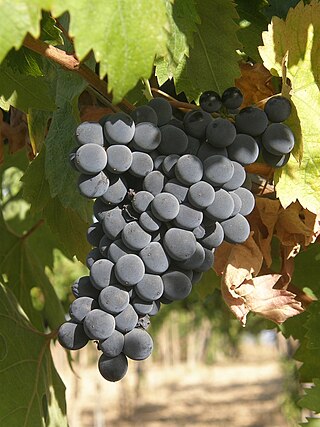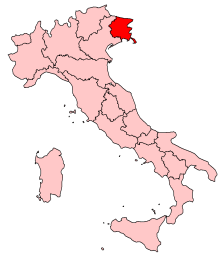Related Research Articles

Brunello di Montalcino is a red DOCG Italian wine produced in the vineyards surrounding the town of Montalcino, in the province of Siena, located about 80 km south of Florence, in the Tuscan wine region. Brunello, a diminutive of bruno, is the name that was given locally to what was believed to be an individual grape variety grown in Montalcino. In 1879 the province of Siena's Amphelographic Commission determined, after a few years of controlled experiments, that Sangiovese and Brunello were the same grape variety, and that the former should be its designated name. In Montalcino the name Brunello evolved into the designation of the wine produced with 100% Sangiovese.
Parrina is a small Italian Denominazione di Origine Controllata comprising parts of the commune of Orbetello in the province of Grosseto, Tuscany. The DOC was awarded in 1971, and extends to 110.33 hectares with about 20 wine producers, the largest of which, by far, is Antica Fattoria La Parrina. The DOC originally allowed only the use of Italian varieties such as Trebbiano, Sangiovese and Ansonica, but an amendment in 1986 recognised emerging trends in allowing the use of Chardonnay, Cabernet Sauvignon and Merlot. About 50% of the wine production is white, 35% red, and 15% rosato. The name "Parrina" may originate from the Castilian word for a pergola on which vines or figs are grown. Others argue the area took its name from the Parrini order which had a monastery here in the twelfth century.

Montepulciano is a red Italian wine grape variety that is most noted for being the primary grape behind the DOCG wines Colline Teramane Montepulciano d'Abruzzo and Offida Rosso; and the DOC wines Montepulciano d'Abruzzo, Rosso Conero, and Rosso Piceno Superiore.

Tuscan wine is Italian wine from the Tuscany region. Located in central Italy along the Tyrrhenian coast, Tuscany is home to some of the world's most notable wine regions. Chianti, Brunello di Montalcino and Vino Nobile di Montepulciano are primarily made with Sangiovese grape whereas the Vernaccia grape is the basis of the white Vernaccia di San Gimignano. Tuscany is also known for the dessert wine Vin Santo, made from a variety of the region's grapes. Tuscany has forty-one Denominazioni di origine controllata (DOC) and eleven Denominazioni di Origine Controllata e Garantita (DOCG). In the 1970s a new class of wines known in the trade as "Super Tuscans" emerged. These wines were made outside DOC/DOCG regulations but were considered of high quality and commanded high prices. Many of these wines became cult wines. In the reformation of the Italian classification system many of the original Super Tuscans now qualify as DOC or DOCG wines but some producers still prefer the declassified rankings or to use the Indicazione Geografica Tipica (IGT) classification of Toscana. Tuscany has six sub-categories of IGT wines today.

Friuli-Venezia Giulia wine is wine made in the northeastern Italian region of Friuli-Venezia Giulia. There are 11 denominazione di origine controllata (DOC) and 3 denominazione di origine controllata e garantita (DOCG) in the Friuli-Venezia Giulia area. The region has 3 indicazione geografica tipica (IGT) designations Alto Livenza, delle Venezie and Venezia Giulia. Nearly 62% of the wine produced in the region falls under a DOC designation. The area is known predominantly for its white wines, which are considered some of the best examples of Italian wine in that style. Along with the Veneto and Trentino-Alto Adige, the Friuli-Venezia Giulia forms the Tre Venezie wine region, which ranks with Tuscany and Piedmont as Italy's world class wine regions.

Orvieto is an Italian wine region located in Umbria and Lazio, centered on the comune of Orvieto. It is primarily known for its white wines made from a blend of mostly Grechetto and Trebbiano, which is sold under the Denominazione di origine controllata (DOC) Orvieto and Orvieto Classico. Blended red wine and eight varietal reds are sold under the Rosso Orvietano DOC. The region has been producing wine since the Middle Ages, when Orvieto wine was known as a sweet, golden-yellow wine. Today's white Orvieto is dry, but a semi-sweet style, known as Orvieto Abboccato, and dolce (sweet), are also produced in small quantities.
Montecarlo is a denominazione di origine controllata (DOC) in northern Tuscany, Italy. The vineyards surround the small town of Montecarlo which is located close to Lucca and Pisa. Montecarlo wines are unusual for the region in that they are commonly made from the Sémillon, Sauvignon blanc and Pinot bianco grape varietals. This is unusual as most Tuscan white wines are made from Trebbiano and Malvasia grapes. Wines from the region are often called the best Tuscan whites.
Drupeggio is a white Italian wine grape variety that is grown in the Central Italy wine regions of Tuscany and Orvieto. The grape is often confused for the white Tuscan variety Vernaccia di San Gimignano, which is also known under the synonym Canaiolo bianco and may be counted as one and the same in field blends.

Pomino is a village belongs to the municipality of Rufina, in the province of Florence, Tuscany, Italy. The village of Pomino is 7,36 kilometers far from the same town of Rufina to whom it belongs. The locality of Pomino rises 585 meters above sea level and the population counts 228 inhabitants.

Bolgheri is a central Italian village and hamlet (frazione) of Castagneto Carducci, a municipality (comune) in the province of Livorno, Tuscany. in 2011 it had a population of 131.

Pecorino is a white Italian wine grape variety that grows in the Marche, Abruzzo, Tuscany, Umbria and Lazio regions of Italy. Ampelographers believe that the grape is likely native to Marche, where the soil destined for this cultivation increases every year. This grape variety is used to produce the DOCG wines, like the Offida Pecorino DOCG, and the DOC wines, like the Falerio dei Colli Ascolani, the Colli Maceratesi and the Falerio dei Colli Ascolani.
Elba is a Denominazione di origine controllata (DOC) wine made from grapes grown on the island of Elba, in the region of Tuscany, Italy. Elba wine can be red, white or sweet, the latter being the island's own version of vin santo. The Elba DOC was created in 1967. Elba rosso is a minimum of 60% sangiovese, while Elba bianco may encompasses several different blends of grapes, of which include Ansonica, Trebbiano Toscano, Vermentino and other white grapes. Rosso riserva wines must be aged for a minimum of two years, including six months in bottle.
Sovana is a denominazione di origine controllata red or rosé wine from the south of Tuscany, in Italy. The DOC is named after the ancient Etruscan settlement of Sovana. Sovana received DOC status in 1999, along with its neighbor, the DOC Capalbio. Sovana encompasses roughly the same areas that produce the white wine Bianco di Pitigliano, and encompasses the towns of Pitigliano, Sorano, Manciano and borders the DOC Morellino di Scansano in the north, and the region of Lazio in the south.
Colli Maceratesi is a denominazione di origine controllata wine made in the province of Macerata, in the Italian region of Marche. The DOC was created in 1975, and allows white and red wines.
Verdea is a white Italian wine grape variety that originated in Tuscany but is today mainly grown in the Lombardy wine region of northern Italy. The grape is sometimes confused with the white Verdeca grape of the Apulia region and the French wine grape Verdesse from Savoy due to similarities in their names and synonyms. Verdea can be used to make a wide variety of wines, ranging from the late harvested Vin Santo to dry sparkling wines.

Abruzzo is an Italian wine region located in the mountainous central Italian region of Abruzzo, along the Adriatic Sea. It is bordered by the Molise wine region to the south, Marche to the north and Lazio to the west. Abruzzo's rugged terrain, 65% of which is mountainous, help to isolate the region from the winemaking influence of the ancient Romans and Etruscans in Tuscany, but the area has had a long history of wine production.

Montefalco wine is a style of Italian wine made in Umbria, and awarded Denominazione di origine controllata (DOC) status in 1979.

Vermentino nero is a red Italian wine grape variety that is predominantly grown in province of Massa-Carrara in Tuscany. After World War II, the vine was almost lost to extinction until Podere Scurtarola, a producer from Massa, began replanting old vineyards with the grape. By 2000, there were 199 hectares of Vermentino nero growing in Italy with the grape authorized for production in the Denominazione di origine controllata (DOC) wines of Candia dei Colli Apuani and Colline Lucchesi.

Nettuno is a DOC wine region in Lazio, Italy, producing both red, white and rosé wines. While the region is known for wine production since Roman times, the DOC was granted as late as in 2003. The DOC area comprises the communes of Nettuno and Anzio.
References
- ↑ "DECRETO 8 luglio 1997". Riconoscimento della denominazione di origine controllata dei vini "Colline Lucchesi" e revoca della denominazione di origine controllata dei vini "Rosso delle Colline Lucchesi" o "Colline Lucchesi" rosso e "Bianco delle Colline Lucchesi" o "Colline Lucchesi" bianco. MINISTERO DELLE POLITICHE AGRICOLE E FORESTALI. 1997.
- ↑ Joseph Batianich & David Lynch Vino Italiano: The Regional Wines of Italy" pg 431 Clarkson Potter Publishers ISBN 9781400097746